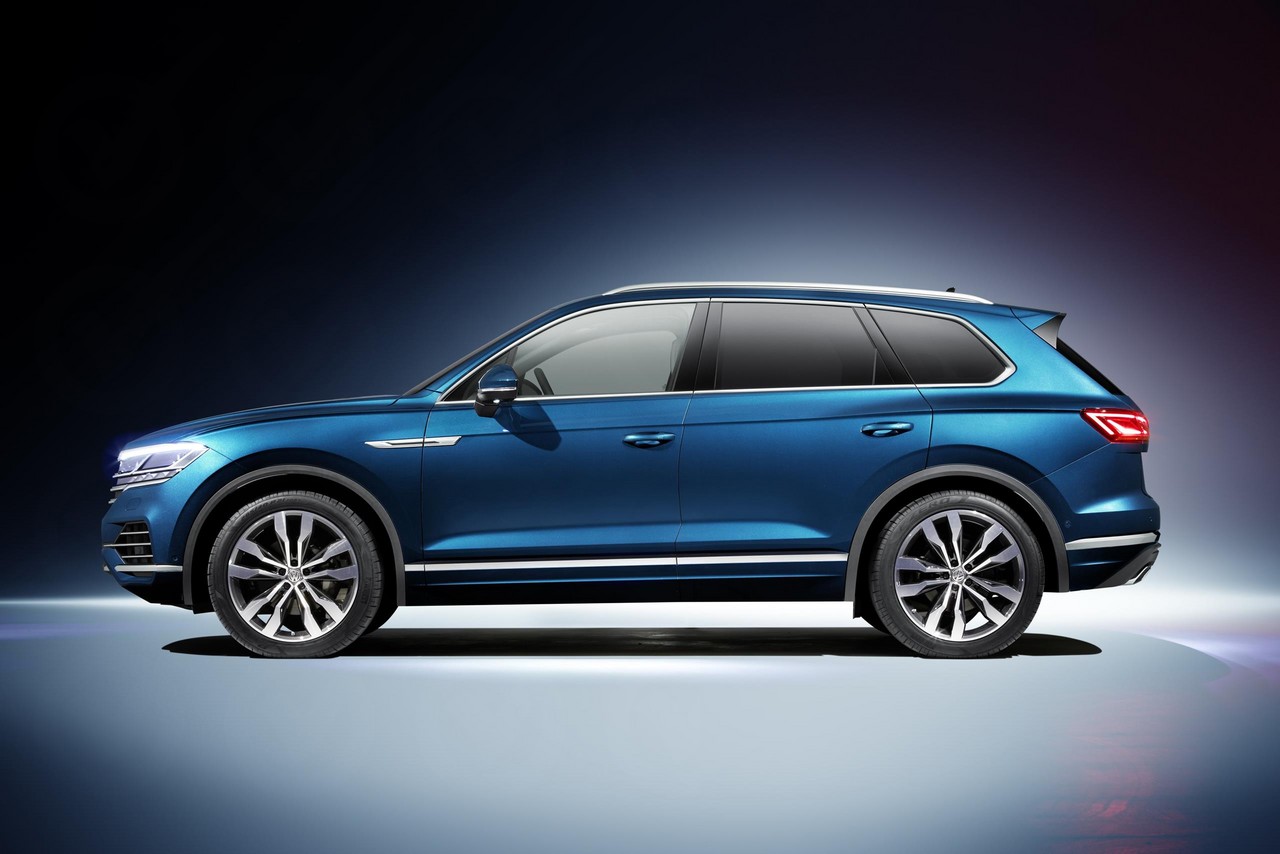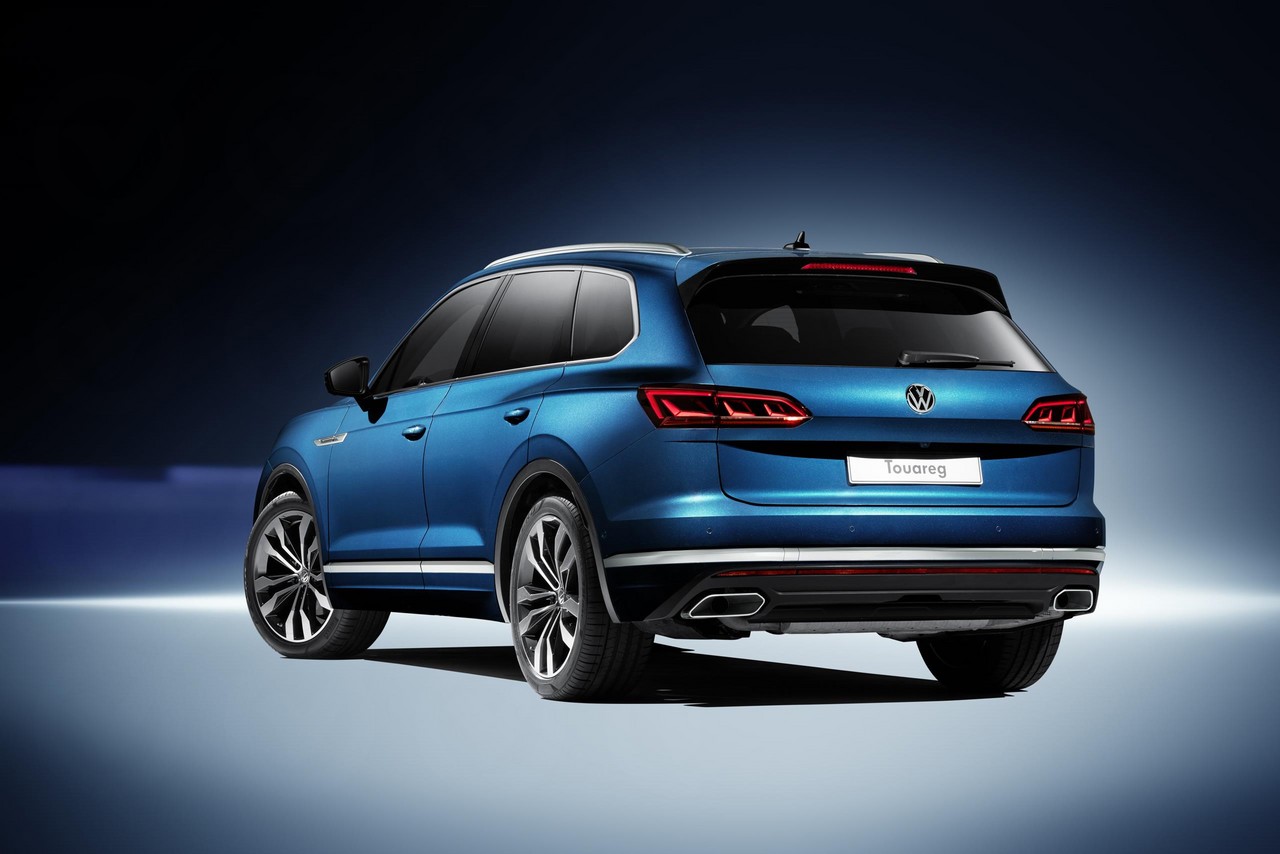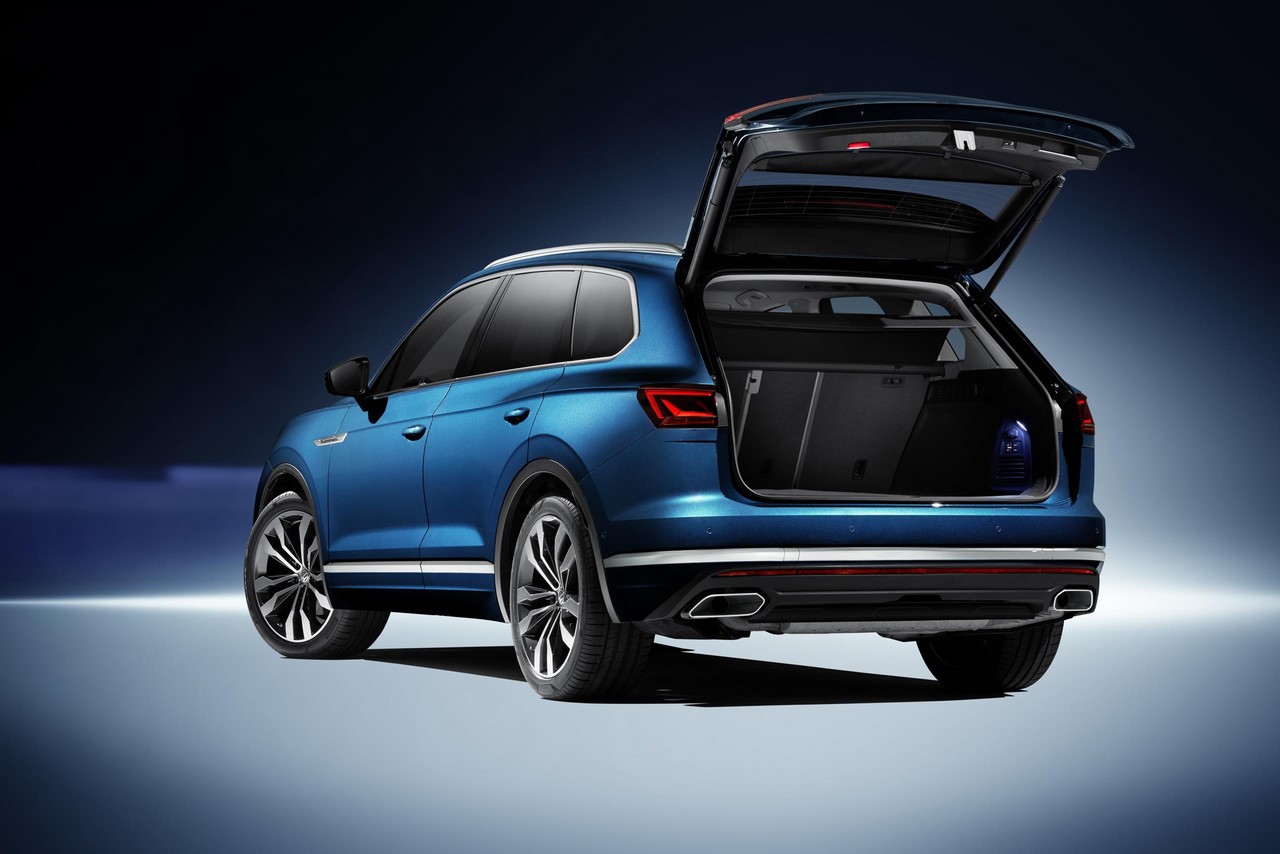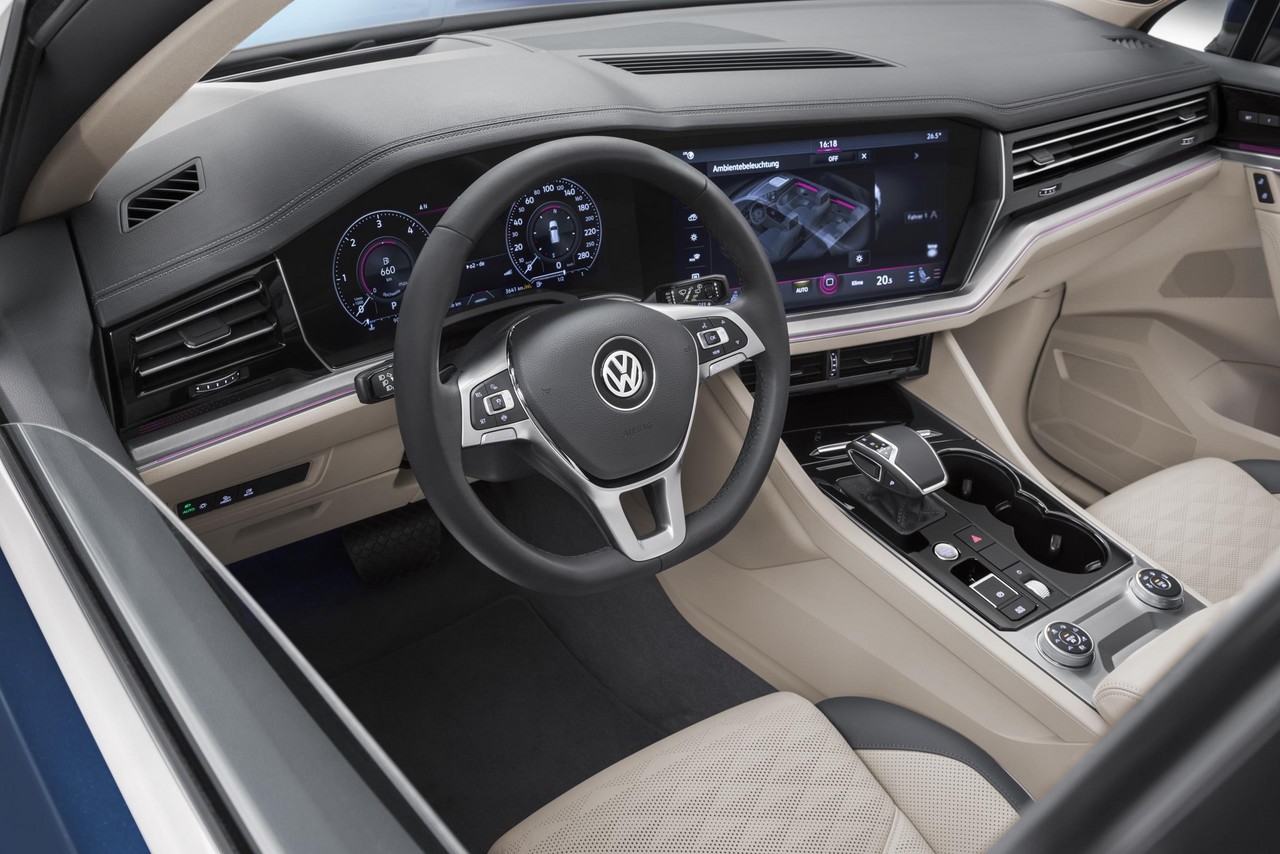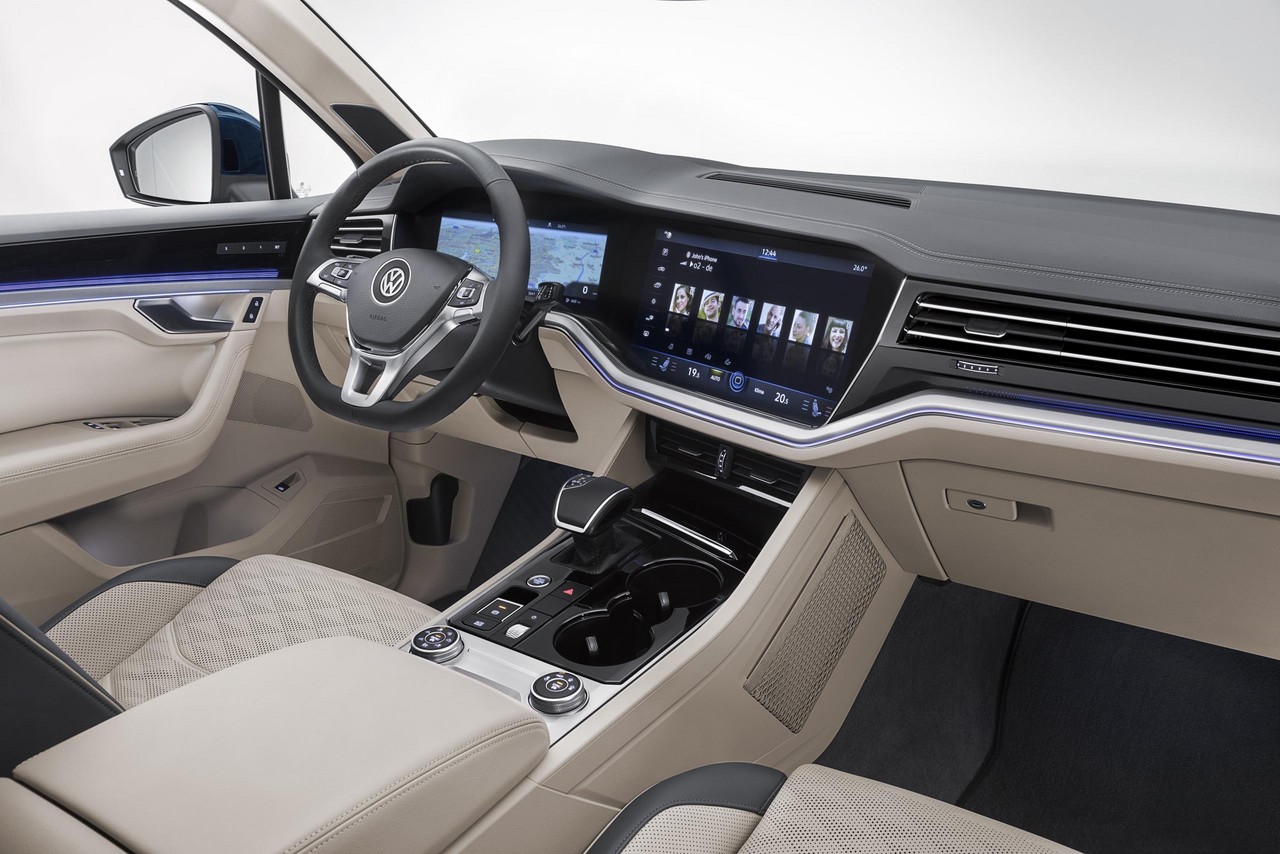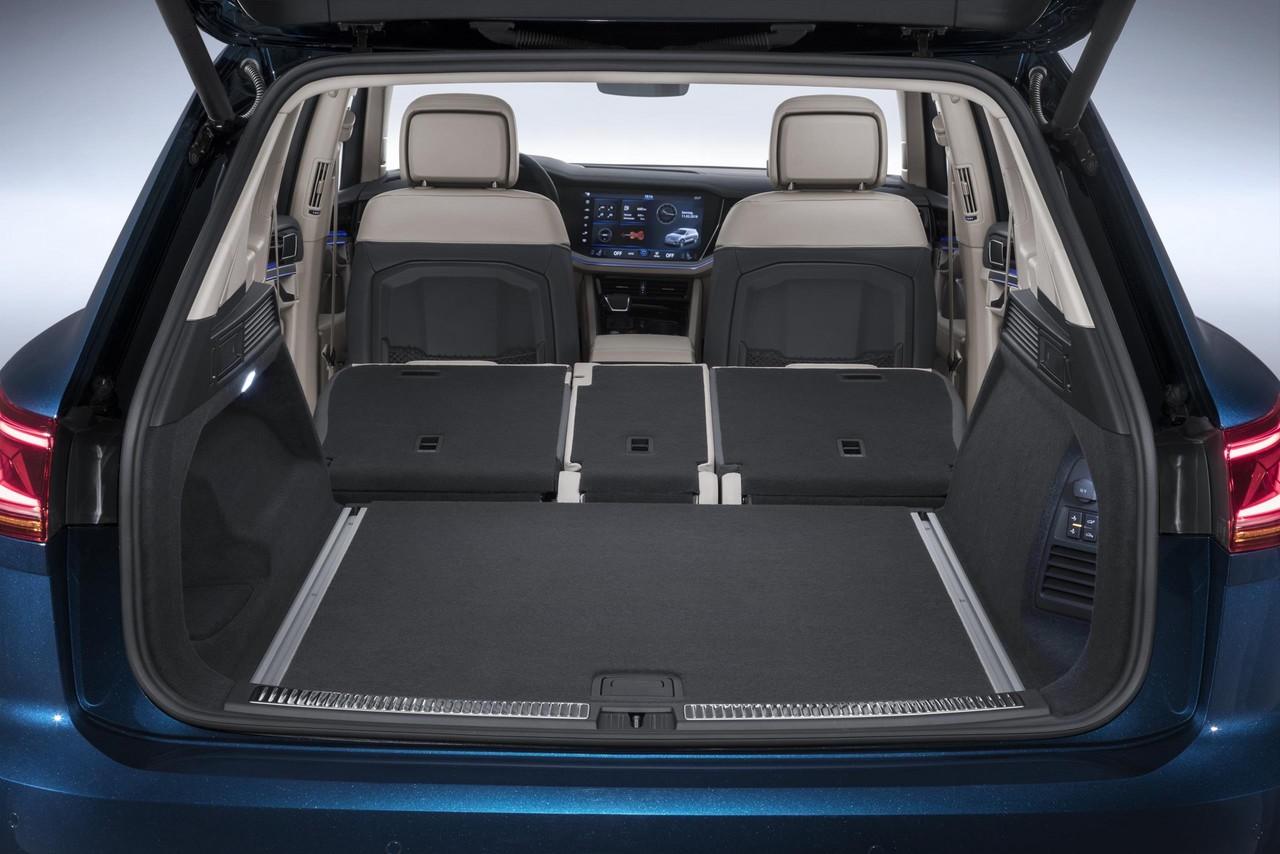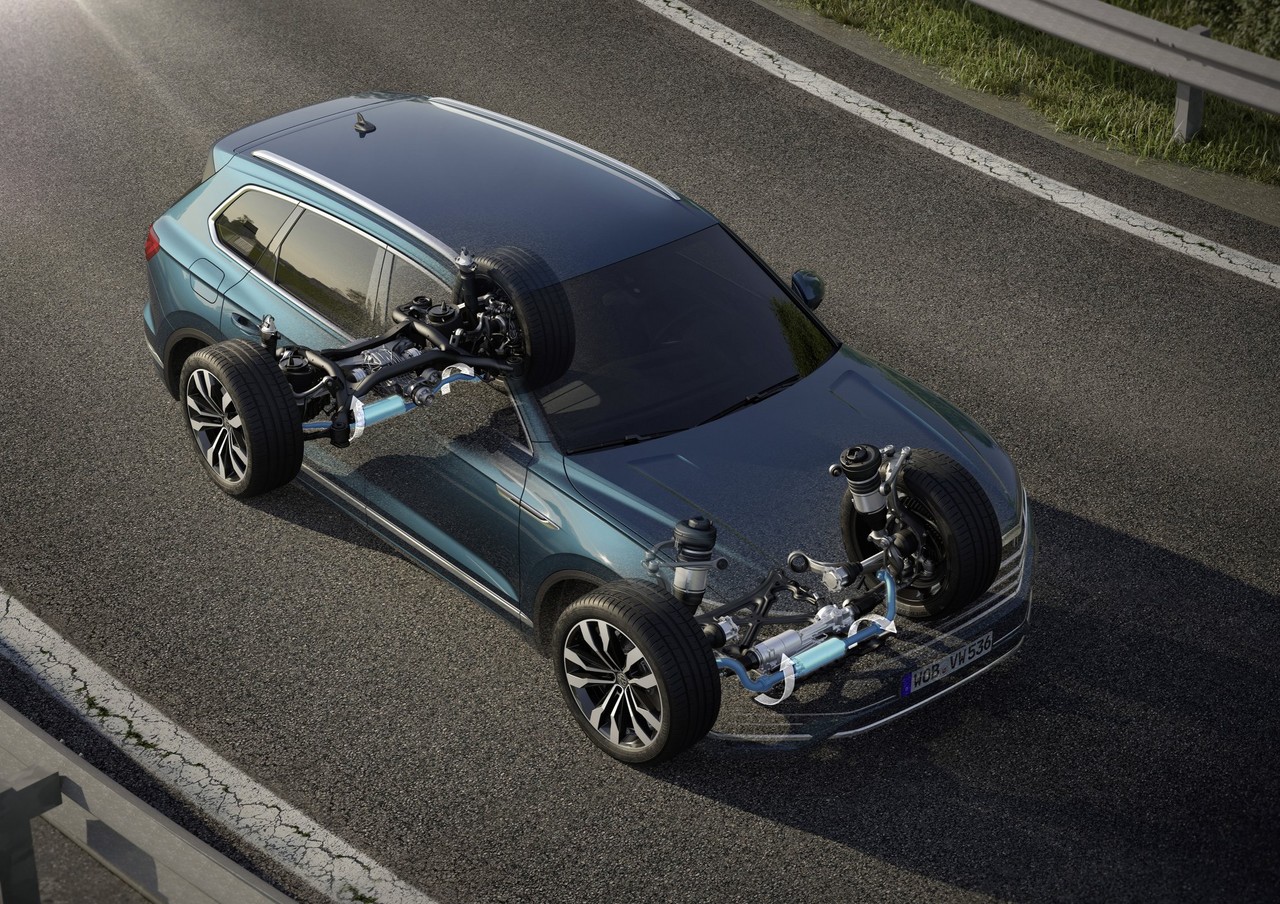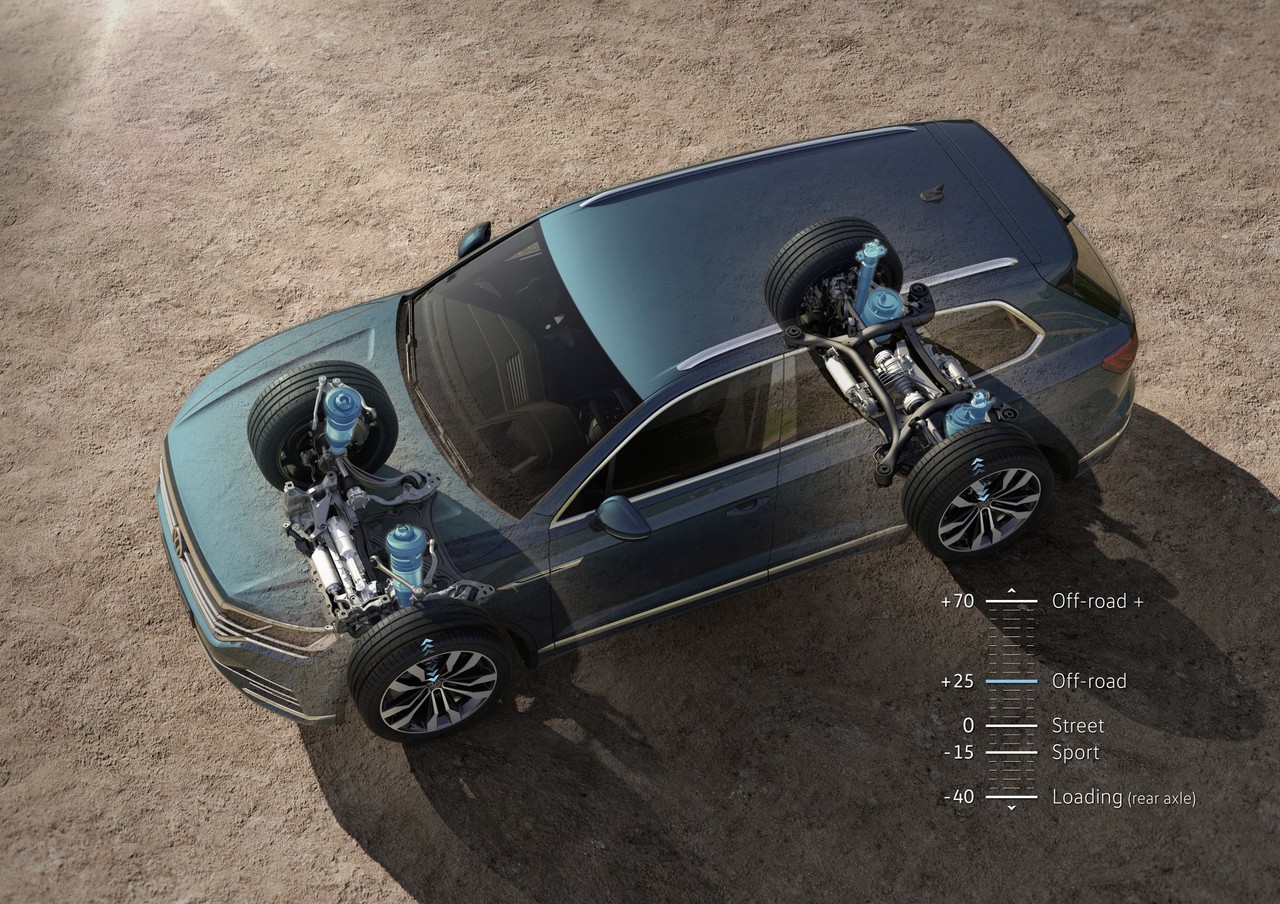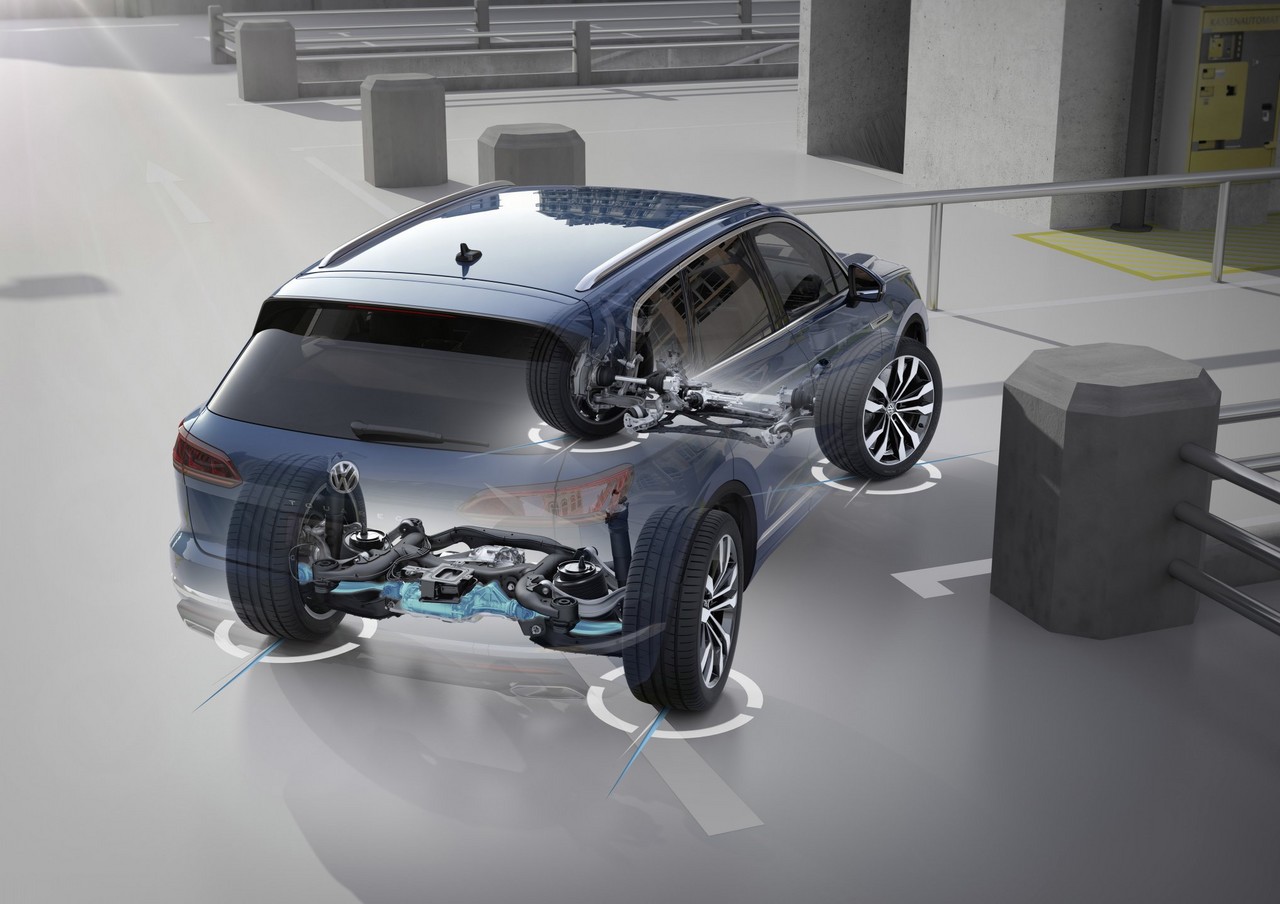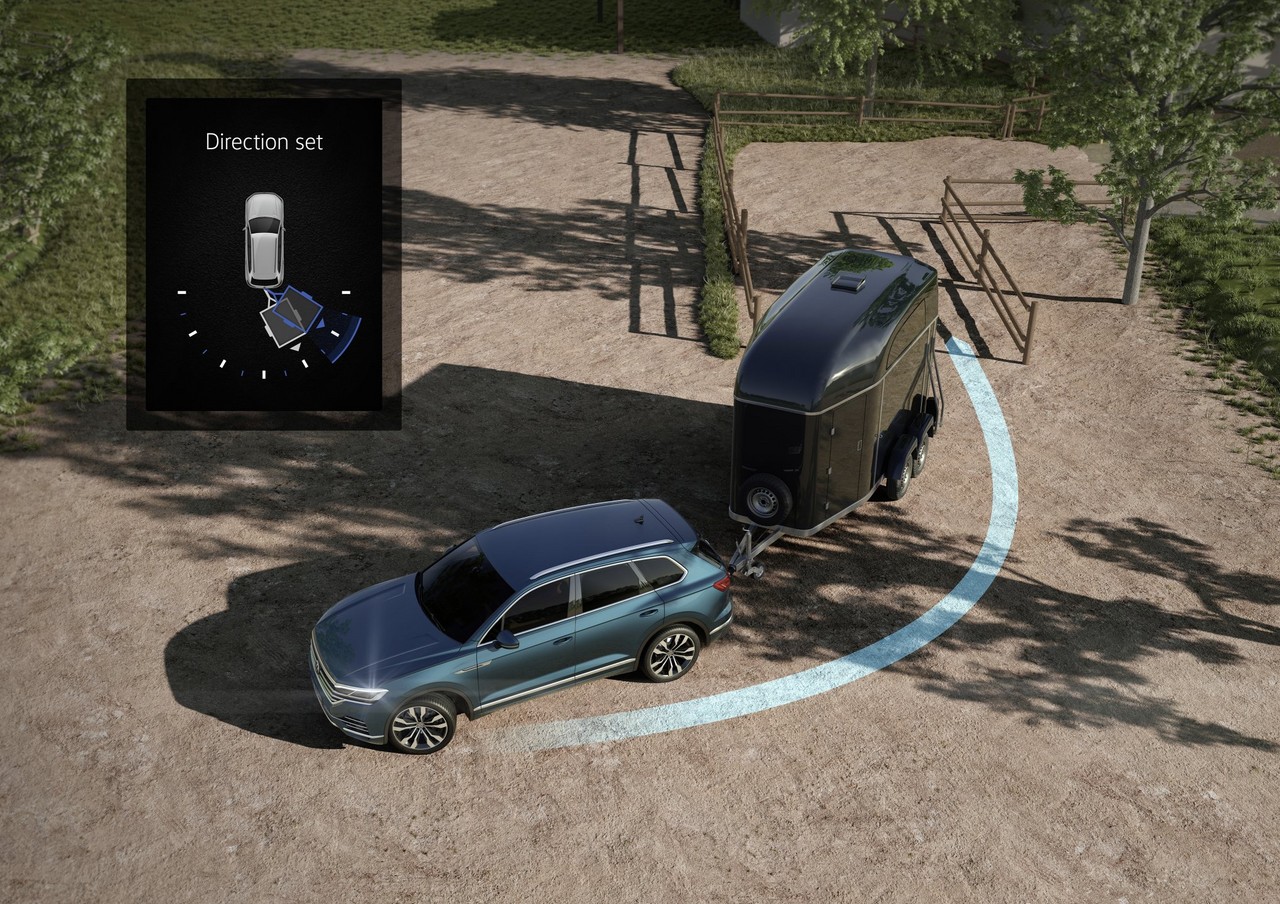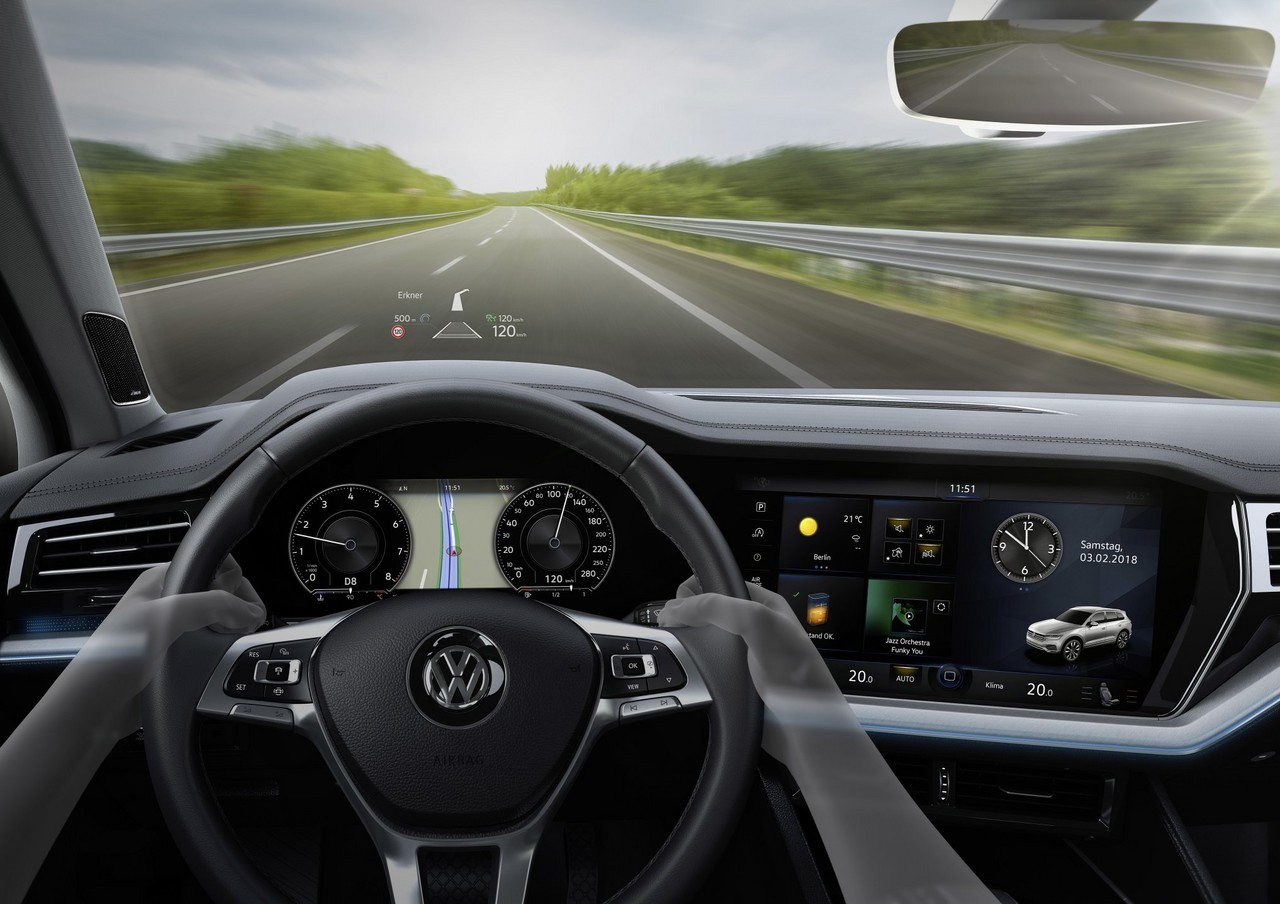
- All-wheel steering reduces turning circle
- ‘Innovision Cockpit’ combines digital instrument cluster and central touchscreen
- Array of active safety technologies
- Optional air suspension
- Ride quality on low-profile tyres?
- Third row headroom?
- Steering feel?
Overview
Production of the third-generation Volkswagen Touareg will commence in July 2018 and it is expected to be released in Australia in late 2018. To be manufactured in Bratislava, Slovakia, the seven-seat Volkswagen Touareg will be available with V6 TSI, plug-in hybrid, V6 TDI and V8 TDI powertrains (see table below), though the range for Australia is yet to be confirmed.
| Variant | Engine | Trans. | Peak power | Peak torque |
|---|---|---|---|---|
| V6 TSI | 2995 cc EA839 turbo petrol V6 | 8sp auto | 250 kW | 450 Nm |
| V6 TDI | 2967 cc turbo diesel V6 | 8sp auto | 170 kW | 500 Nm |
| V6 TDI | 2967 cc turbo diesel V6 | 8sp auto | 210 kW | 600 Nm at 2250-3250 rpm |
| V8 TDI | 3956 cc biturbo diesel V6 | 8sp auto | 310 kW | 900 Nm |
4MOTION all-wheel drive
AustralianCar.Reviews expects that the ‘4MOTION’ all-wheel drive system for the Volkswagen Touareg will consist of a self-locking centre differential that is integrated into the housing of the eight-speed automatic transmission. In normal conditions, the centre differential provides a 40:60 front:rear torque split. In the event that a wheel loses traction, however, up to 70 per cent of available torque can be directed to the front axle or 85 per cent to the rear axle.
Body and dimensions
The third-generation Volkswagen Touareg is underpinned by Volkswagen AG’s MLB platform which is shared with the Audi 4M Q7 , Porsche E3 Cayenne and Bentley Bentayga . Compared to the Volkswagen 7P Touareg , the Touareg III is 20 mm shorter (at 4878 mm), 19 mm wider (1984 mm) and 15 mm lower (1717 mm), though wheelbase length is unchanged (2904 mm). Furthermore, the body of the third-generation Touareg is 106 kg lighter due to its mixed material construction in which aluminium is used for 48 per cent of the body and high-tech steels are used for the remaining 52 per cent.
Suspension
The Volkswagen Touareg is understood to have five-link front and rear axles. To reduce mass, the links are made from aluminium and high-strength steel, the cardan shafts of the front axle are hollow and the pivot bearings are aluminium forgings.
As an option, the Volkswagen Touareg will be available with –
- Adaptive air suspension which enables the body to be lowered by up to 40 mm when driving at highway speeds for greater aerodynamic efficiency and raised by up to 70 mm for increased ground clearance when driving off-road;
- Electronically controlled dampers; and,
- Electronically controlled anti-roll bars.
Steering
The Volkswagen Touareg III has electromechanical power-assisted steering and all-wheel steering. With all-wheel steering, an electric spindle drive can turn the rear wheels inward by up to five degrees. At speeds below 37 km/h, the rear wheels turn – by up to five degrees – in the opposite direction to the front wheels to reduce the vehicle’s turning circle from 12.19 to 11.19 metres. At speeds above 37 km/h, however, the rear wheels turn in the same direction to improve vehicle stability.
Safety equipment
Standard safety equipment for the Volkswagen Touareg includes dual front airbags, front and second row seat-mounted side airbags, full-length curtain airbags, ABS, electronic brake force distribution, brake assist, electronic stability control, traction control and front seatbelts with pre-tensioners and load limiters.
AustralianCar.Reviews expects that the Volkswagen Touareg will be equipped with the following active safety technologies –
- Front Assist: uses a radar sensor to detect if the vehicle is closing too fast on the vehicle ahead. If this occurs, Front Assist 1) provides audible and visual warnings to the driver, 2) brings the brake pads into contact with the brake discs in preparation for an emergency stop; and, 3) provides a jolting brake application to alert the driver. If the driver fails to respond, Front Assist applies the brakes automatically to avoid or reduce the severity a collision;
- City Emergency Brake: an extension of Front Assist, City Emergency Braking operates at speeds up to 65 km/h and uses a radar sensor and front camera to monitor the area ahead for vehicles and pedestrians. If a collision is anticipated, the driver is alerted via visual and audible warnings, followed by jolting brake application. If the driver fails to respond, the system initiates emergency braking;
- Adaptive Cruise Control (ACC): using a radar sensor, ACC can apply the vehicle’s brakes to reduce vehicle speed and maintain a pre-set distance to vehicle ahead. ACC can also cause the vehicle to accelerate back to its cruising speed once the road ahead clears;
- Lane Assist (lane departure warning): using a camera to recognise lane markings, Lane Assist could detect unintentional lane drifting or changing and provide corrective steering actions for up to eight seconds. If the corrective steering actions were insufficient, the driver would be warned via steering wheel vibrations;
- Traffic Jam Assist: uses Adaptive Cruise Control (ACC) to provide automatic braking and accelerating in the stop-and-go speed range and the Lane Assist function to keep the Touareg in the middle of its lane;
- Emergency Assist 2: if a lack of steering activity indicates that the driver is inactive or incapacitated while Adaptive Cruise Control and Lane Assist are engaged, Emergency Assist 2 alerts the driver with an intermittent gong, jolting brake application and steering wheel vibrations. Furthermore, Emergency Assist 2 uses Side Assist (described below) to indicate and safely change lanes to the far left lane or emergency lane (depending on traffic and road conditions) before bringing the vehicle to rest;
- Side Assist (lane change assistant): operates at speeds of 10 km/h and uses two radar sensors in the rear bumper to monitor the area up to 70 metres behind the vehicle. If a vehicle is detected to be approaching from the rear or alongside the Touareg, the driver is warned by illumination of an LED in the door mirror housing. If the driver then activates the turn indicator in the direction of the detected vehicle, the Side Assist indicator flashes to draw the driver’s attention to the mirror. If the driver attempts to steer into that area, Lane Assist provides a counter-steering action to prevent the lane change;
- Rear Traffic Alert: when the driver is attempting to reverse out of a parking space, Rear Traffic Alert uses radar sensors in the rear bumper to detect traffic up to 50 metres away that may cross the vehicle’s intended path. If a collision risk is detected, Rear Traffic Alert provides a visual warning, followed by an audible warning. If the driver does not respond to the warnings and there is an immediate collision risk, Rear Traffic Alert automatically applies the brakes;
- Proactive occupant protection system: uses the rear radar sensors to anticipate rear-end collisions. If there is a collision risk, the hazard warning lights would display the emergency collision alert signal and the Touareg prepares for impact by closing all windows (except for a narrow gap that improves the bracing effect of the front head airbags), closing the sunroof (where fitted) and using the belt tensioners to tighten the front seatbelts;
- Manoeuvre braking: when reversing at speeds up to 10 km/h, ‘Manoeuvre braking’ can initiate emergency braking if a collision risk is detected;
- Driver Fatigue Detection: operating at speeds over 65 km/h, Driver Fatigue Detection monitors steering wheel movements for signs of fatigue. If detected, the driver receives a warning in the multi-function display and an acoustic signal. The warning is repeated after 15 minutes if the driver has not taken a break; and,
- Multi-collision brake: after a collision, multi-collision brake automatically applies the brakes for controlled deceleration to reduce vehicle speed and the likelihood of a second collision.
The Volkswagen Touareg will also introduce the following safety technologies –
- Night Vision assistance: uses a thermal imaging (infra-red) camera to detect objects such as standing, non-concealed pedestrians, cyclists and larger wild animals at a range of 10 to 130 metres ahead. If such a being is detected in a defined corridor or, in the case of people, once they are expected to enter this corridor, the driver receives a warning in the Digital Cockpit (i.e. the Touareg’s digital instrument panel). Beings detected outside the risk corridor are highlighted in yellow on the monochrome image created by the night vision system. If these beings traverse certain boundaries along the road, the highlighting is changed from yellow to red. Even if the display for the Night Vision system is not activated in the Digital Cockpit, the screen automatically switches to this mode when danger is detected, vehicle speed exceeds 50 km/h and beings are in the risk corridor;
- Roadwork Lane Assist: semi-automated steering, lane-keeping, accelerating and braking at speeds up to 60 km/h; and,
- Front Cross Traffic Assist: can react to traffic crossing in front of the Touareg by applying the vehicle’s brakes to prevent a collision.
Euro NCAP testing
In Euro NCAP testing , the Volkswagen Touareg received a five star safety rating which included an 89 per cent adult occupant protection rating and an 86 per cent child occupant protection rating. In the frontal offset test, protection of the driver’s head, thighs and feet were rated as good, while lower leg protection was rated as adequate (i.e. a slight risk of serious injury) and chest protection as marginal (a moderate risk of serious injury). While maximum points were awarded in the side impact test, chest protection for the driver in the pole test was rated as marginal.
Features: Volkswagen Touareg III
Inside, the Volkswagen Touareg will feature an ‘Innovision Cockpit’ which consists of:
- A ‘digital cockpit’ with 12-inch display; and,
- A ‘Discover Premium’ infotainment system which has a 15-inch display.
It is unclear, however, if the Innovision Cockpit will be fitted as standard.
The Volkswagen Touareg will also be available with a ‘Windshield Head-up Display’ which projects directly onto the windscreen and ‘IQ.Light’ LED matrix headlights which can briefly flash to identify and warn people in a potential danger area when the vehicle is outside urban areas and travelling at speeds above 60 km/h.
Further information regarding features will be available closer to launch.

